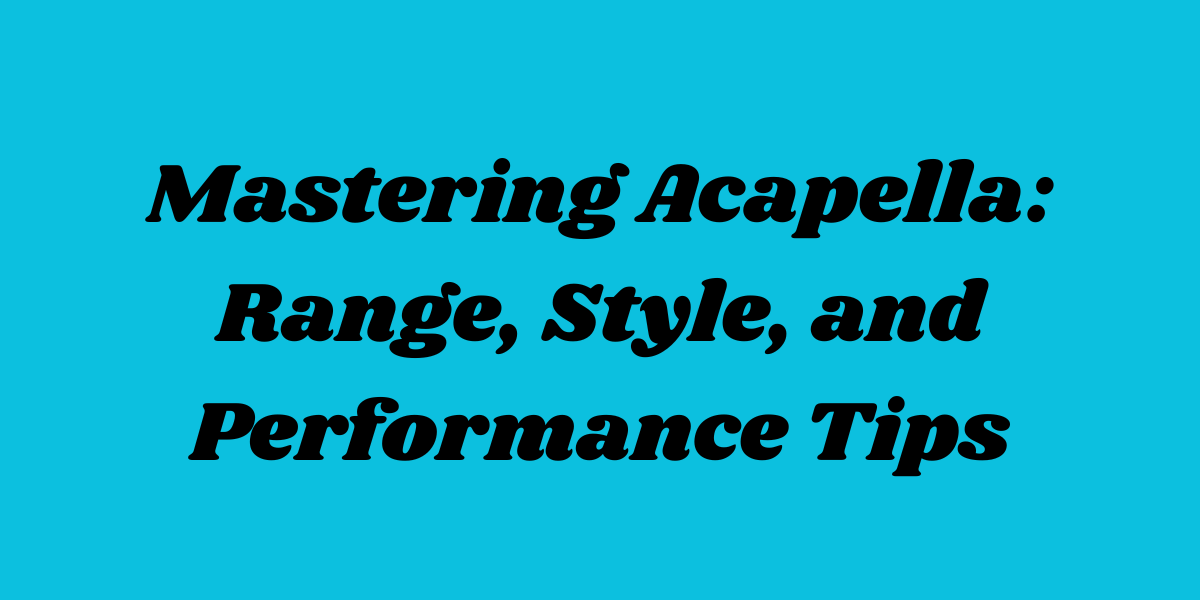
Acapella is one of the most expressive forms of singing, showcasing the raw power and versatility of the human voice. Without any instrumental backing, the voice takes on the role of melody, harmony, and rhythm. Mastering acapella requires control, creativity, and confidence but once achieved, it can elevate your singing to a whole new level.
In this guide, we’ll explore the essentials of acapella: understanding vocal range, experimenting with styles, and polishing your skills for a powerful acapella performance.
Why Acapella Matters for Singers
Singing acapella strengthens your voice in unique ways. Since there are no instruments to rely on, you must depend on your ear, pitch control, and rhythm. Some key benefits include:
Improved Pitch Accuracy – You learn to stay in tune without a piano or guitar guiding you.
Greater Vocal Strength – Singing without support builds projection and clarity.
Enhanced Creativity – You can mimic instruments or experiment with harmonies.
Confidence Building – Performing solo acapella boosts stage presence and vocal independence.
Step 1: Know Your Vocal Range
Every acapella singer needs to know their vocal range. It defines the notes you can sing comfortably and helps you choose songs that suit your voice.
Start with warm-ups to avoid strain.
Use a keyboard or tuner to find your lowest and highest notes.
Map your results on a vocal range chart to understand your strengths.
Knowing your range ensures you stay within safe limits while also giving you the confidence to expand your abilities over time.
Step 2: Explore Acapella Styles
Acapella is incredibly versatile, and different styles highlight different skills:
Choral Acapella – Traditional group singing in harmony.
Barbershop Quartet – Four voices blending in close harmony.
Contemporary Acapella – Modern groups like Pentatonix mixing pop, R&B, and beatboxing.
Solo Acapella – A single singer carrying melody, harmony, and sometimes rhythm.
Experimenting with these styles will help you find your unique voice and performance approach.
Step 3: Practice Essential Techniques
To excel in acapella, focus on techniques that build control and flexibility:
Breath Control – Strong breath support keeps your voice stable.
Harmony Training – Practice singing alongside recordings or with partners.
Vocal Percussion – Learn simple beatboxing to add rhythm.
Resonance Shifts – Move smoothly between chest, head, and mixed voice.
Consistency in these exercises will sharpen your overall singing ability and prepare you for live performances.
Step 4: Preparing for Acapella Performance
Performing acapella is different from singing with a band or backing track. Here are some tips to deliver your best:
Choose the Right Song – Pick one that fits your range and showcases your vocal strength.
Control Pitch – Use a starting note or pitch pipe before beginning.
Engage the Audience – With no instruments, your expression and stage presence become more important.
Blend in Groups – Match tone and volume carefully if singing with others.
If you want to take your skills further, explore structured guides on acapella performance to build stage confidence and technique.
Step 5: Overcoming Common Challenges
Acapella singers often face these difficulties:
Pitch Drift – Losing key without instrumental reference.
Rhythm Control – Maintaining tempo when singing alone.
Stage Nerves – Performing without musical support can feel intimidating.
The solution lies in consistent practice, recording yourself, and gradually building performance confidence.
Conclusion
Mastering acapella is about more than singing without instruments it’s about discovering your voice in its purest form. By understanding your vocal range, practicing essential techniques, and learning to perform confidently, you can deliver powerful and memorable performances.
Whether solo or in a group, acapella offers singers a chance to shine without distractions, letting the human voice take center stage. With dedication and practice, your next acapella performance can showcase the full depth and beauty of your voice.


